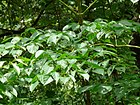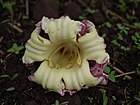Note: This is a project under development. The articles on this wiki are just being initiated and broadly incomplete. You can Help creating new pages.
Difference between revisions of "Oroxylum indicum - Shyonaka"
(→Habit) |
|||
| Line 1: | Line 1: | ||
[[File:Oroxylum indicum W3 IMG 3170.jpg|thumb|right|''Oroxylum indicum'', ''Shyonaka'']] | [[File:Oroxylum indicum W3 IMG 3170.jpg|thumb|right|''Oroxylum indicum'', ''Shyonaka'']] | ||
| − | '''Shyonaka''' is a species of flowering plant belonging to the family Bignoniaceae | + | '''Shyonaka''' is a species of flowering plant belonging to the family Bignoniaceae. It is a tree which can reach a height of 12 metres. |
| − | |||
==Uses== | ==Uses== | ||
{{Uses|Wounds}}, {{Uses|Cuts}}, {{Uses|Snakebites}}, {{Uses|Curing liver disorders}}, {{Uses|Skin eruptions}}, {{Uses|Blotches}}, {{Uses|Pimples}}, {{Uses|Diarrhea}}, {{Uses|Sore throats}} | {{Uses|Wounds}}, {{Uses|Cuts}}, {{Uses|Snakebites}}, {{Uses|Curing liver disorders}}, {{Uses|Skin eruptions}}, {{Uses|Blotches}}, {{Uses|Pimples}}, {{Uses|Diarrhea}}, {{Uses|Sore throats}} | ||
| Line 9: | Line 8: | ||
==Chemical Composition== | ==Chemical Composition== | ||
| − | Baicalein, oroxylin and pinostrobin along with one sterol, Stigmast | + | Baicalein, oroxylin and pinostrobin along with one sterol, Stigmast.<ref name="chemical composition"/> |
==Common names== | ==Common names== | ||
| Line 35: | Line 34: | ||
==Identification== | ==Identification== | ||
===Leaf=== | ===Leaf=== | ||
| − | {{Leaf|Compound| | + | {{Leaf|Compound|Triangular|2-3 pinnate, pinnae 5-9; imparipinnate, opposite; leaflets 3-5 in each pinnae, opposite, 7.5-15 x 4-9 cm, ovate, apex acuminate.}}<ref name="Leaf"/> |
===Flower=== | ===Flower=== | ||
| − | {{Flower|Bisexual|10cm long| | + | {{Flower|Bisexual|10cm long|Reddish-purple and pinkish-yellow|5|Flowers in terminal racemes, large, reddish-purple and pinkish-yellow within}} |
===Fruit=== | ===Fruit=== | ||
| − | {{Fruit| | + | {{Fruit|Flat|30-90 cm long||Compressed, tapering at both ends|Seeds thin, papery, 5-6 cm long, winged all around except at base.}} |
===Other features=== | ===Other features=== | ||
| Line 57: | Line 56: | ||
==How to plant/cultivate== | ==How to plant/cultivate== | ||
| − | Seed is the best propagation material and should be collected before split- ting of pods during February–March. Seed germination percentage is 80%–90% without any pretreatment. <ref name="How to plant/cultivate"/> | + | Seed is the best propagation material and should be collected before split- ting of pods during February–March. Seed germination percentage is 80%–90% without any pretreatment.<ref name="How to plant/cultivate"/> |
==Commonly seen growing in areas== | ==Commonly seen growing in areas== | ||
| Line 74: | Line 73: | ||
<references> | <references> | ||
| − | <ref name="chemical composition">[https://www.nepjol.info/index.php/SW/article/view/3852 | + | <ref name="chemical composition">[https://www.nepjol.info/index.php/SW/article/view/3852 Chemical constituents]</ref> |
| − | <ref name="Leaf">[https://indiabiodiversity.org/species/show/16688 | + | <ref name="Leaf">[https://indiabiodiversity.org/species/show/16688 Morphology]</ref> |
| − | <ref name="Ayurvedic preparations">[https://easyayurveda.com/2014/07/22/sona-patha-oroxylum-indicum-benefits-side-effects-research/ | + | <ref name="Ayurvedic preparations">[https://easyayurveda.com/2014/07/22/sona-patha-oroxylum-indicum-benefits-side-effects-research/ Ayurvedic preparations]</ref> |
| − | <ref name="How to plant/cultivate">[http://vikaspedia.in/agriculture/crop-production/package-of-practices/medicinal-and-aromatic-plants/oroxylum-indicum | + | <ref name="How to plant/cultivate">[http://vikaspedia.in/agriculture/crop-production/package-of-practices/medicinal-and-aromatic-plants/oroxylum-indicum Cultivation details]</ref> |
</references> | </references> | ||
Revision as of 15:22, 10 June 2020
Shyonaka is a species of flowering plant belonging to the family Bignoniaceae. It is a tree which can reach a height of 12 metres.
Contents
- 1 Uses
- 2 Parts Used
- 3 Chemical Composition
- 4 Common names
- 5 Properties
- 6 Habit
- 7 Identification
- 8 List of Ayurvedic medicine in which the herb is used
- 9 Where to get the saplings
- 10 Mode of Propagation
- 11 How to plant/cultivate
- 12 Commonly seen growing in areas
- 13 Photo Gallery
- 14 References
- 15 External Links
Uses
Wounds, Cuts, Snakebites, Curing liver disorders, Skin eruptions, Blotches, Pimples, Diarrhea, Sore throats
Parts Used
Chemical Composition
Baicalein, oroxylin and pinostrobin along with one sterol, Stigmast.[1]
Common names
| Language | Common name |
|---|---|
| Kannada | Tattuna |
| Hindi | Bhut-vriksha |
| Malayalam | Palaqapayyani |
| Tamil | Cori-konnai |
| Telugu | Pampena |
| Marathi | NA |
| Gujarathi | NA |
| Punjabi | NA |
| Kashmiri | NA |
| Sanskrit | Aralu, Shyonaka |
| English | Broken Bones Tree, Indian Trumpet Flower |
Properties
Reference: Dravya - Substance, Rasa - Taste, Guna - Qualities, Veerya - Potency, Vipaka - Post-digesion effect, Karma - Pharmacological activity, Prabhava - Therepeutics.
Dravya
Rasa
Tikta (Bitter), Kashaya (Astringent), Madhura (Sweet0
Guna
Laghu (Light), Ruksha (Dry)
Veerya
Ushna (Hot)
Vipaka
Katu (Pungent)
Karma
Kapha, Vata
Prabhava
Habit
Identification
Leaf
| Kind | Shape | Feature |
|---|---|---|
| Compound | Triangular | 2-3 pinnate, pinnae 5-9; imparipinnate, opposite; leaflets 3-5 in each pinnae, opposite, 7.5-15 x 4-9 cm, ovate, apex acuminate. |
Flower
| Type | Size | Color and composition | Stamen | More information |
|---|---|---|---|---|
| Bisexual | 10cm long | Reddish-purple and pinkish-yellow | 5 | Flowers in terminal racemes, large, reddish-purple and pinkish-yellow within |
Fruit
| Type | Size | Mass | Appearance | Seeds | More information |
|---|---|---|---|---|---|
| Flat | 30-90 cm long | Compressed, tapering at both ends | Seeds thin, papery, 5-6 cm long, winged all around except at base. | {{{6}}} |
Other features
List of Ayurvedic medicine in which the herb is used
Where to get the saplings
Mode of Propagation
How to plant/cultivate
Seed is the best propagation material and should be collected before split- ting of pods during February–March. Seed germination percentage is 80%–90% without any pretreatment.[4]
Commonly seen growing in areas
Tropical area, Borders of forests and fields.
Photo Gallery
References
External Links
- Ayurvedic Herbs known to be helpful to treat Wounds
- Ayurvedic Herbs known to be helpful to treat Cuts
- Ayurvedic Herbs known to be helpful to treat Snakebites
- Ayurvedic Herbs known to be helpful to treat Curing liver disorders
- Ayurvedic Herbs known to be helpful to treat Skin eruptions
- Ayurvedic Herbs known to be helpful to treat Blotches
- Ayurvedic Herbs known to be helpful to treat Pimples
- Ayurvedic Herbs known to be helpful to treat Diarrhea
- Ayurvedic Herbs known to be helpful to treat Sore throats
- Herbs with Roots used in medicine
- Herbs with Leaves used in medicine
- Herbs with Fruits used in medicine
- Herbs with Seeds used in medicine
- Herbs with common name in Kannada
- Herbs with common name in Hindi
- Herbs with common name in Malayalam
- Herbs with common name in Tamil
- Herbs with common name in Telugu
- Herbs with common name in Sanskrit
- Herbs with common name in English
- Habit - Tree
- Index of Plants which can be propagated by Seeds
- Index of Plants which can be propagated by Cuttings
- Herbs that are commonly seen in the region of Tropical area
- Herbs that are commonly seen in the region of Borders of forests and fields
- Herbs
- Ayurvedic herbs that don't have seed photos
- Bignoniaceae





